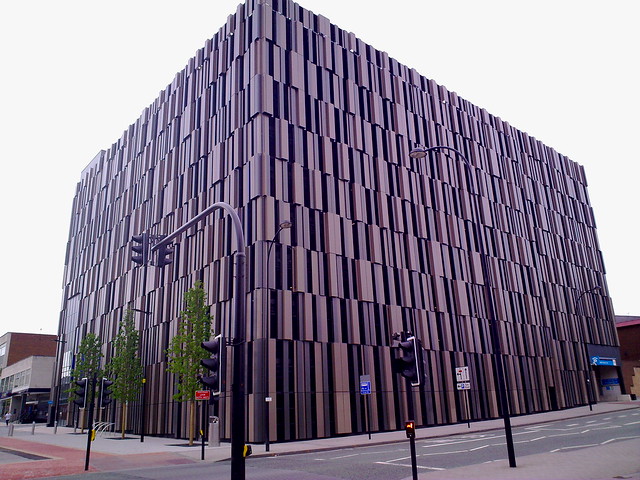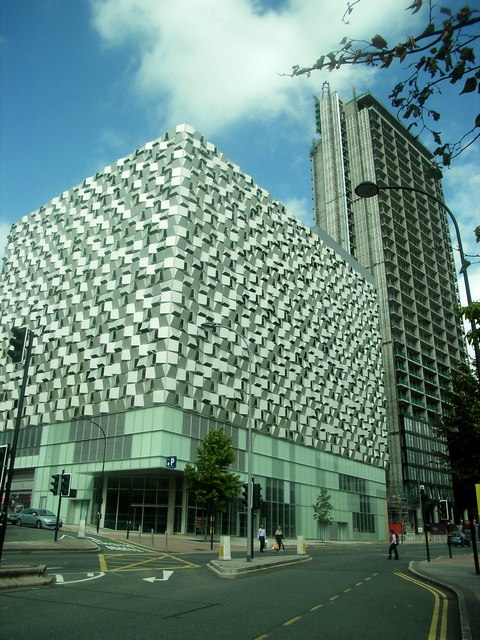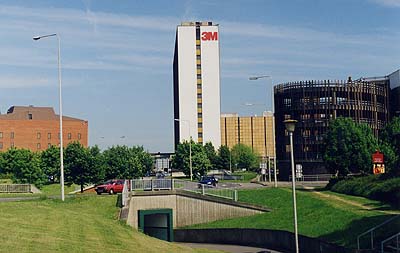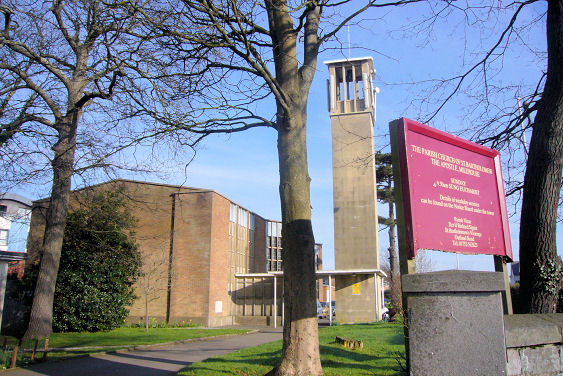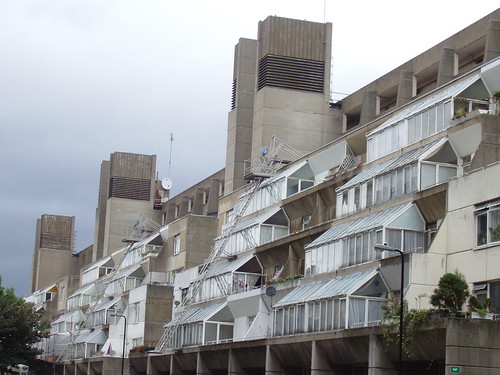![]() You don't need to be an 'investor' to invest in Singletrack: 6 days left: 95% of target - Find out more
You don't need to be an 'investor' to invest in Singletrack: 6 days left: 95% of target - Find out more
Beacon Tower, Fishponds, Bristol. It's astonishing. I can't actually find a photo of it, I assume most cameras commit suicide if you try.
You know the magic ratio of proportions used to create a graceful, balanced structure? There is an opposite, and that figure is hidden somewhere in the measurements of this building. It's too short to actually be a tower for a start, but too regular to be a turd. It really does deserve some sort of a prize for unfeasibly bad design. It's not ugly as such, just.. just [i]wrong[/i].
Skelmersdale new town from end to end we start with this
[img]  [/img]
[/img]
linked bty the bridge of sighs to this
[img] [/img]
exiting to this Italian plaza with this
[img] http://t3.gstatic.com/images?q=tbn:ANd9GcQ6Jnr9YsW7j8MRRc-RvREmsOwS2Z_BM4oXBzmxalaUFJTO38L3dQ [/img]
That is literally the town centre nuking it from orbit is not enough
Lol at Kingsgate above (durham) - that building was award winning when built. Good drinks promos however even in the late 90's.
I really agree with the slating of Southampton in particular but the more general issue I have is that while I understand post-war austerity led to poor/stopgap buildings successive council planning departments and developers have continued the abuse - the attitude seems to be that the town already looks like sh**e so let anyone build any old rubbish they want.
I'd rather see a slightly more picky approach that forces architects to consider creating 'new' uses for the space than simply building another box with some wood stuck on the front and an asymetric window halfway up. The current recession isn't going to help this either.
I kinda like the brutalist style of architecture.. Reminds us of the time when concrete was the go to material of the future.. It all looks ugly to us now but at the time it was the stuff of Buck Rodgers et al..
So.. Let's see.. Here in scotchland, anything by Messrs Gillespie, Kidd and Coia would prob work.. Cardross Seminary perhaps? Now sitting ruined, crumbling and on the endangered list. Once a stunning building inside and out, have wandered round it recently and you can still imagine how it would have been so exciting to look at when new..
Then: [IMG]  [/IMG]
[/IMG]
Just to prove concrete can be done sympathetically: [IMG]  [/IMG]
[/IMG]
Thank you Frank Lloyd Wright!
Sorry, that "after" pic of the seminary is prob a bit optimistic, was prob taken 10 or 15 years ago.
Place is much worse now.. Deteriorating quite badly, would be surprised if, in the current financial climate, it'll be restored/saved..
Managed to have a "cheeky" look at the place.. The collapsed suspended wooden lecture theatre ceiling almost made me cry!!
Sigh.
Ps, props to elfin for these threads.. Love my buildings, history etc..
flying ox - i like the carpark in sheffield and the one below it
The new Civil Justice Building in Manchester.Designed by a kid with a messy bedroom.
I really like that building, not entirely sure why though.
Not surprised at how many times Bristol has appeared on this thread though!
Ahhh of course Frank Lloyd Wright... Yes I remember him back at skooldayz..
Tortured soul it seems, you can tell by the angsty and ugly things he designed later in life. Some early stuff was ok, but only just... BonkersMate, should never have been handed a 2B pencil. He seems to have influenced far too many RIBA'ets for my liking, effortlessly trying to out do their once mentor no doubt only to end up in a Block Style reminiscent of Lego, no doubt on thier way out of the council offices whilst walking out on strike.. Utterly Yuk and a limited mental approach to containment rather than expansion, like a lot of the Politics of the day. Although some of his furniture and glass works was quite inspirational.
One day we’ll decide to expand our vision, until that day we have to suffer the indignity of seeing these aborhant buildings and worst of all they’re smack bang in the centers of some gowd forsaken “New Town”.
And you can’t say they didn’t know concrete degraded over time, nor that steel rods rust inside them.. they knew that all along.
I say stand up and take the critism sonnyjim.
^^ what he said^^
concrete makes sense in California and other hot places..
Not in the uk tho, and most of northern Europe too now I think about it!!
Let's not forget that bloody Bauhaus movement neither! It's fine for an exhibition piece but not for residences that folk actually have to live in that have asthma and similar illnesses!
Amazing anyone gets better there.
The original old building is worse - it's like something out of Dickens. Scandalous that it has taken so long to move wards out of there!
That said, the peeps I know at the BRI work bludy hard - hats off to 'em.
Very pleased to see that Binnerses' theme of hatred has produced such a fascinating thread. Always good to let of steam over stuff. I've literally stopped in my tracks and sworn out loud in disgust at some buildings. Crimes against Humanity, no excuses, shoot the architects. Would send a message to others that if they are going to design something we've all got to look at/work in/live in, then bloody well make sure and do a decent job, don't just take the money and produce some half-arsed pile of crap.
I was put in mind of New York; a city fabled for it's architecture, yet take away just the handful of really decent buildings, and what are you left with? Mainly a bunch of soulless characterless identikit boxes. Mind you, at least it has a handful of decent buildings; I cannot say the same for Warrrington I'm sorry it's got to be said. 🙁
Warrington Bank Quay station, with the Unilever plant behind:
Britain's most Unromantic Station. They imposed a 'no kissing' zone there. They din't need to; nobody would ever have any feelings of love, affection or romance in such a soulless dump.
It's true, here is the sign:
And here is the best thing to come out of Warrington:
A friend of mine is from Warrington (as is Binners, which may explain the bitterness). I was quite saddened when he told me he will 'never live there again'. 🙁 A person should be proud and fond of where they are from. He isn't.
Glad that Bristol's getting some stick, but at least they had the good sense to level this monstrosity:
[img]  [/img]
[/img]
However, the rest of Broadmead really needs a bus-sized chunk of rock dropped on it from orbit. Broadmead Baptist Chapel; not entirely sure what deity I'd expect to materialise when summoned in here:
[img] 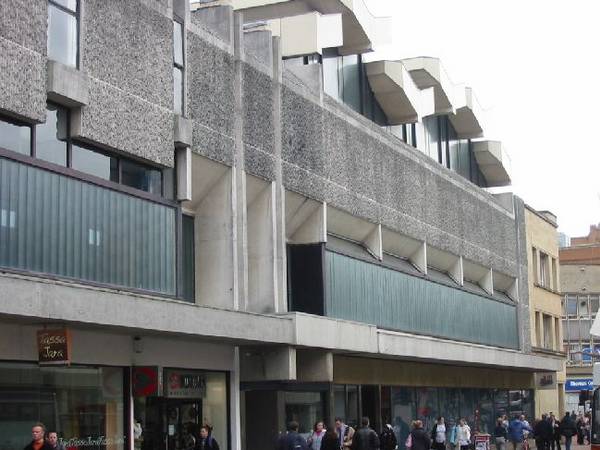 [/img]
[/img]
At least the centre of Broadmead had a nice little green feature in 1973:
[img]  [/img]
[/img]
Sadly, though, this ugly excrescence still exists:
[img]  [/img]
[/img]
There was a bomb scare:
[img] 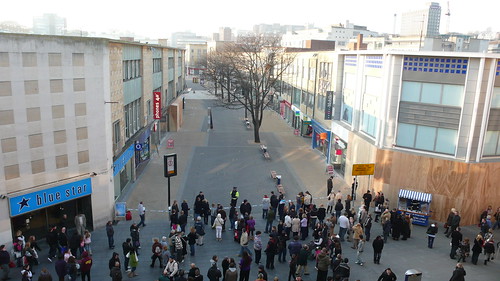 [/img]
[/img]
unfortunately it was just a scare, and this grimy, down at heel part of Bristol is still in existence.
Now I'm a huge fan of Church Buildings, no honestly I am, doesn't matter what denomination, I just love the design and thought process and beauty..
This is in Cheltenham..
[img] http://www.urc.org.uk/church/get_photo?id=671 [/img]
The entire village of Poundbury. Good old carbuncle face Chaz sticking his oar in on town planning - "I know, let's build a new town for people to live in but make it just like an old town, because lifestyles, architecture and materials haven't moved on in the last few hundred years have they???". No, not when you live in the isolated bubble of the monarchy they haven't! Other countries seem to know how to build modern housing that actually works, that people want to live and and that doesn't look like it came from some time before the mid 70s, but we just get served up the same formulaic Barrat home dross time and time again, and Chaz's exercise in retrospective luvviness does nothing to alter that situation.
hudds uni central services building...
Gah!
It's all starting to make sense. I always wondered why I only managed 1 year of Architecture before switching to Chemistry. It's because that year was spent in Huddersfield. That building is exactly the kind of architecture I think they were aspiring to.
I want to know, maybe you lot can help me out here..
Why is it that our town/city centers are so crammed together..? You know.. the roads are so narrow, buildings stacked up on one another, homes are pinned against each other, it's no supprise that our "living spaces" have turned out like boxes.
And I know a lot has to do with Ancient Historic villages/rights of way etc.. But I'm talking about the differance between the UK and Europe where is the most part towns and cities are much more spaced out..
I think we should have just built on farmland regardless of planning laws (which are boooolocks IMO)
But discussing planning laws is taking this way OT..
I think a lot of it is due to the Industrial Revolution and the migration of country folk into the towns in search of jobs. Before the presence of any kind of public transport system these people had to live within walking distance of the factories they worked in, leading to the cramped streets we're stuck with today.
Sorry I don't know how to post a photo but Bessemer Park in Spennymoor was an abomination (thankfully gone now).
Just looking at the old photos makes me feel ill .....
The difference between Europe and the UK is that we spent quite a considerable number of years bombing, shelling and fighting across quite a lot of it with the unexpected side effect of requiring many urban areas to be rebuilt - sometimes twice. Whereas we haven't - except for the east end of London and Coventry.
Whereas we haven't - except for the east end of London and Coventry.
Bristol, Hull, Manchester etc also took more than a few hits.
Having looked at the pictures in some books about architecture, I can understand where architects and town planners wanted to create iconic new 'visions' for urban living and social organisation and that, it's just that they were woefully naive and ignorant to what people would actually [i]need[/i].
I mean, take Le Corbusier. Talented bloke, good at designing stuffs. Done some good buildings and that. But did he ever have to live in a Unite d'Habitation? No. Which is where the problem lies; no empathy in such buildings, for those who must dwell in them.
The Robin Hood Gardens case is a striking one, in that it was only people who had no experience of living in the dump that wanted it listing. Shows the gulf that often exists between architect and end user.
The same is true of most corporate buildings today; might look all sleek and shiny on the outside, but they're often lined with utterly soulless, depressing office space that doesn't make the workers inside feel too happy about their working environment.
The Brunswick Centre; hailed as a great new way for people to live, with recreation spaces and shops and stuff included in the plan. The reality is that it's a concrete mess; shoddily built and depressing:
Or you can take a picture in the 60s, in Black and White, and it looks all cool and futuristic:
This is suppopsed to be the way forward. The contempary yet vast and repugnant Beetham Tower in Deansgate Manchester.
It looks like two old-style Playstation 2s stacked on top of each other. :/
May I propose that Wolverhampton University's School of Art and Design be added to this noble list?
And it looks even more stunning by night:
And from my hometown:
What I don't understand, Elfin, is how The Brunswick Centre is a mess and the majority of the Madrid population lives in flat or things like the eight house are seen as a future solution.
Actually the various Unite are seen as desirable places to live now, there's one town that has even finished a LC church inn order to bring people to the area as it is in a former mining area that has some very run down areas.
I think its quite interesting that 50s architecture seems to be universally reviled - personally I think that much of it has a considerably better urban presence and sympathetic nature than many buildings constructed in the last 10 years.
[edit] The Barbican whilst difficult to navigate is absolutely fantastic - helped in no small part by the CorpofLondon carrying out excellent maintenance on it.
I think its quite interesting that 50s architecture seems to be universally reviled
Not universally, just the crap stuff.
personally I think that much of it has a considerably better urban presence and sympathetic nature than many buildings constructed in the last 10 years.
I agree.
OK then, go and live in one of them then. Go and live in something like Robin Hood Gardens then see how much you like that kind of architecture.
how do you know i haven't, don't or wouldn't ? the idea that these buildings are the cause of social misery ignores the fact that society is generally the cause of social misery not arcitechture. people have always lived perfectly happily in flats in england and the rest of the world. when parkhill is redeveloped and sold to people with prospects and happiness will it look like it did 20 years ago ? no.
Then come and talk to me about the 'Human Condition'
i lived on a large council block estate (now demolished) in brum and i saw lots that was to be admired about the human condition, people really making an effort whilst faced with awful problems. i suppose its easy for folks to look down their noses at people though
Robin Hood Gardens failed as a means of housing the families for which it was apparently designed, cos the architects had bugger all genuine understanding of the real needs of those who were going to inhabit their 'visionary' design. Designed to house those who lived in near-poverty, without understanding the issues faced by those who actually do live in near-poverty. It is, quite simply, not fit for purpose.
I've lived on housing estates pretty much all me life mate, and have seen all sorts of changes and transitions. I think I've got a pretty good understanding of how such communities exist. And one thing I do know; large, sprawling estates where people are actually, by architecturally design, cut off from the very neighbours the architects imagined they'd all be conversing with so happily, do not engender happiness in people whose lives are already fairly miserable, as a whole.
You're a small kid, and you live near the top of a tower block. The ground is a long way away, and your mum is loathe to let you out because she can't actually keep an eye on you as she'd want to. So, instead of being out with your mates playing in the sunshine, you're cooped up indoors.
You're an elderly person and/or someone with mobility problems. The lifts have broken down yet again. You need to do some shopping. You can't even call on a neighbour because all the ones on your floor are out at work.
You're coming home late one night. The street lights aren't really very effective at illuminating the dark alleyways and corners of the buildings. The area is a hotspot for crime. You're frightened and feel very vulnerable.
You're a young mum with a pram and a load of shopping. You live several floors above ground level. The lifts are broken down again....
You were saying?
Robin Hood Gardens failed as a means of housing the families for which it was apparently designed, cos the architects had bugger all genuine understanding of the real needs of those who were going to inhabit their 'visionary' design. Designed to house those who lived in near-poverty, without understanding the issues faced by those who actually do live in near-poverty.
How are the three problems of vandalism the fault of the architects? And even the first issue you mention is has not been caused by the architect.
Many families in Spain live very happily on the 10th, 11th or even 12th floor of a city centre building.
The architects aren't responsible for the behaviour of the residents.
How are the three problems of vandalism the fault of the architects?
RHG was built in an area where poverty was rife. Crime, such as robbery, drug-dealing/taking, and vandalism are commonplace. The architects failed to consider such issues, as well as the needs of families/elderly people/those with mobility problems, yet considered their work to be the best solution to the problem of housing people from what was previously slum tenements and run-down terraces, mostly.
RHG may well have worked in an area not beset with the issues Poplar suffers from. But to build such a thing where they did, was a huge mistake. All they've created is another slum.
Large apartment blocks can work in areas with low crime and relative affluence, and where things like lifts and street lighting are well-maintained. They don't work in the East End. Which is why most of the larger buildings here have bin demolished, to make way for more suitable lower-rise blocks, and a return to terraced housing with gardens and that. Indeed, in areas where such re-development has happened, people's lives have benefitted.
The architects aren't responsible for the behaviour of the residents.
They are, however, along with the relevant authorities, responsible for providing housing solutions which engender positive relations within communities, and not producing festering sores on the face of architectural history.
So more the fault of the local authority for commissioning the buildings and failing to maintain them, than the architects, no?
Local Authority and the architects. The designers of the buildings had a duty to research the particular needs of the tenants who were going to inhabit their creations. The failed in that duty. No good them turning round to defend their own failures and getting their architect/designer/artist mates to back up their feeble arguments.
What they designed din't work. Therefore it cannot be considered 'successful' architecture.
Fair enough.
Indeed Sir, city planners and architects alike have conspired against to perform the most basic of human needs..
A Life of meaningful exsistance.
Instead they've created slums of penned in, contained, sardine like, chicken coups that were desperatly poorly made by people who often ended up living in them, or needed to put thier own families in them and lets face it..
Had no other choice.
Therin lies the responcibility of the Planners (cough) and architects to provide suitable accomodation.
And the only reason the Barbican is still standing is because of the billions spent on it to maintain the crumbling infrastructure.. made out of what I hear you ask..
C o n crete.
**sighs** as though central government funding and a desire in the post war to try and improve conditions for those who lived in slums was a crime.
Apparently it is though.
There's rather more to commissioning new buildings than just asking an architect to design it - those paying the bill usually have a considerable amount of input into the final outcome. But then it's easier just to blame the men I'm black.
Me I like the fact that middle class architects, the middle class planners and the middle class councilers thought that they'd better coup up the working (or benifit) class in the smallest possible footprint and damn the consequencies.
Means us aspiring folk can buy somewhere near the middle of a town and not be over run by oiks dont it? 200 flats 10 stories high doesnt take up a lot of room, and with half the folk to scared to come down stairs, that's less people about as well. Imagine all those [i]working[/i] class people actually able to impact on your daily life... Doesn't bare thinking about.
**sighs** as though central government funding and a desire in the post war to try and improve conditions for those who lived in slums was a crime.
Not saying it was a 'crime', just that the architects weren't up to the task they were given.
The Smithsons can't just walk away from the RGH project and say 'well, we're not responsible for the crime and poor living conditions of those what live in our design', cos they've helped create them. Not deliberately, no, but they've made a mistake, and they, and the planners, LA etc should hold their hands up and say 'we have failed the people who we were sposed to help'.
But they've all had their payday and buggered off into the sunset of whatever lovely place they undoubtedly live in.
I'm sorry aP; I admire your defence of them, and I do very much respect your onion about stuff, but RHG, and many other social housing projects of that era, are a failure.
Damn it, I want to offer up Curzon House, Leicester for this thread but the internet rejects all searchs of pictures for it. Maybe the eyesore's been destroyed... One can only hope.
You're a small kid, and you live near the top of a tower block. The ground is a long way away, and your mum is loathe to let you out because she can't actually keep an eye on you as she'd want to. So, instead of being out with your mates playing in the sunshine, you're cooped up indoors.You're an elderly person and/or someone with mobility problems. The lifts have broken down yet again. You need to do some shopping. You can't even call on a neighbour because all the ones on your floor are out at work.
You're coming home late one night. The street lights aren't really very effective at illuminating the dark alleyways and corners of the buildings. The area is a hotspot for crime. You're frightened and feel very vulnerable.
You're a young mum with a pram and a load of shopping. You live several floors above ground level. The lifts are broken down again....
You were saying?
I was saying that people live quite happily in flats all over the world. people are happy when they've got a decent wage and prospects and live in misery when they don't.
For someone who's supposed to have lived on estates you seemed to have failed to grasp those two realities.
The Smithsons can't just walk away from the RHG project and say 'well, we're not responsible for the crime and poor living conditions of those what live in our design', cos they've helped create them. Not deliberately, no, but they've made a mistake, and they, and the planners, LA etc should hold their hands up and say 'we have failed the people who we were sposed to help'.
yep. trouble is the succesful corb stuff (which all the likes of RHG was inspired by) eg unite marseilles, was never designed to be for socially deprived groups. it was intended for reasonably wealthy folk, doctors etc.
for those places to work you need the fees for the upkeep, secure porters, other stuff (gym, shops, modern art in the corridors etc)....
that is IMV the big error of the UK's version of high-rise/modern blocks. It should be for the wealthy. 🙂
I do understand where you're coming from, and I think it's great that people try out bold new ideas, enabling progression and evolution, but when it comes to housing people, you kind of have to know what you're doing, and maybe experimentation sometimes has to be tempered with the need to stick with what works. Speshly when it's people's lives that will be affected by what you do.
Sadly, it's the failures of that era that will be remembered, not so much the successes. I do actually like a bit of Brutalism, in a context where it is successful. Like the Barbican concert venue for example.
As for
the idea that these buildings are the cause of social misery ignores the fact that society is generally the cause of social misery not arcitechture.
I disagree. It's hard to be all happy and cheerful when the environment you're in is dingy, oppressive and depressing. People have no pride in their environment, so tend not to care. A walk round my estate reveals this perfectly; the terraced houses with gardens are far better looked after than the flats in the bigger blocks. And the people who live in each are roughly in the same economic situation.
Barbican estate is a good example. some of the most pricey stuff in london, top flats- I've lived in one of the towers.
Alan the porter, top bloke.
High density housing does not have to be as bad as it often is here.
Plus, it's easy to blame the architects, but there were a whole shedload of other problems that had to be addressed in a hurry in the 60s. You seem to forget huge swathes of city housing were demolished in a matter of months.
. A walk round my estate reveals this perfectly; the terraced houses with gardens are far better looked after than the flats in the bigger blocks. And the people who live in each are roughly in the same economic situation.
So how would you explain the trashing of houses and the general area around the old Queen's Park, Wrecsam, and area of housing, not high rise.
Why not pop up to have a wander around Blacon one evening? OK, in Blacon there are a couple of high rise, but not around Stamford Rd. And yet nearer the station there are the same style high rise buildings which quite respectable. Strange, innit?
I disagree. It's hard to be all happy and cheerful when the environment you're in is dingy, oppressive and depressing. People have no pride in their environment, so tend not to care. A walk round my estate reveals this perfectly; the terraced houses with gardens are far better looked after than the flats in the bigger blocks. And the people who live in each are roughly in the same economic situation
yeah but you can't just draw a paralell between the two because different factors determine the outcomes, for instance the council will give priority to housing families in houses and young single people in flats. when i was young and living in a flat, i didn't really give two shits what my environment looked like, tbh i had other issues to deal with and different priorities.
are you telling me that all tower blocks are dismal and depressing ? i don't think so. i think lots turned out that way because of poor housing policies and poor economic poicies not always because of bad design.
i happen to think that that estate in london with all the 45 degree angles is visually stunning. would i want to live there ? not really because of factors other than the arcitechture.
Elfin,
Are you professionally involved in the industry (Construction, architect or similar?)
All it is, you present a new and often entertaining thread about architecture as it is an obvious personal interest, yet you (appear to) have a limited understanding (within the opinions expressed in this thread) of how the 'design' process can manifest.
Architects are not always the leading influence and often have to design to a very specific brief. A brief which is often the product of many ill-informed departments having their two-penneth.
Just to clarify, I am not an architect, not my cup of tea.
Yeah, got to say that some of the old terraced estates in Leicester were enough to make my finger nails crawl. Windows breeze blocked up, still people living in the houses. Monday morning on the way to work looked like the end of a civil war. Not a pleasent enviroment. Oh, and it was also one of the not so bad area, Aylestone, roughly 1996ish. Pleased to be gone.... However, I think that it's still a preferable enviromet to the St Mathews style tower blocks. I wouldn't drive through there on a Monday morning!
Kevj - to give Elfin his due he did say above that he considered both architects and planners to be jointly responsible, which is pretty much the case.
I've worked in a LA planning department for a few years (not as a planner before I get crucified!), and they are responsible not just for the 'planning' but also the development of generic design guidance for their area. And as you say, those who write the project brief carry a degree of responsibility, as dothe architects who then interpret that direction into the specific design.
yet you (appear to) have a limited understanding (within the opinions expressed in this thread) of how the 'design' process can manifest.
Oh right ok then.
As SueW sez; I'm not blaming the architects entirely, but they, alongside others responsible, should hold their hands up and say 'yeah, we got it wrong, we're sorry'. That never seems to happen, people just blame some reason other than their own input.
Anyway tasty bacony mushroomy pasta with mozarrella.
I should be back later though.
X
[url= http://www.bbc.co.uk/news/in-pictures-13979860 ]http://www.bbc.co.uk/news/in-pictures-13979860[/url]
I think some are.







